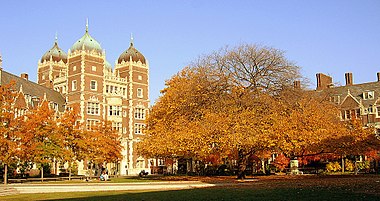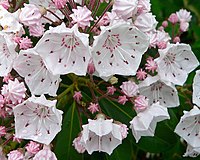The Pennsylvania Portal Pennsylvania (/ˌpɛnsɪlˈveɪniə/ PEN-sil-VAY-nee-ə, lit. 'Penn's forest country'), officially the Commonwealth of Pennsylvania (Pennsylvania Dutch: Pennsylvanie), is a state spanning the Mid-Atlantic, Northeastern, Appalachian, and Great Lakes regions of the United States. It borders Delaware to its southeast, Maryland to its south, West Virginia to its southwest, Ohio and the Ohio River to its west, Lake Erie and New York to its north, the Delaware River and New Jersey to its east, and the Canadian province of Ontario to its northwest via Lake Erie. Pennsylvania was founded in 1681 through a royal land grant to William Penn, the son of the state's namesake. Prior to that, between 1638 and 1655, a southeast portion of the state was part of New Sweden, a Swedish Empire colony. Established as a haven for religious and political tolerance, the colonial-era Province of Pennsylvania was known for its relatively peaceful relations with native tribes, innovative government system, and religious pluralism. Pennsylvania played a vital and historic role in the American Revolution and the ultimately successful quest for independence from the British Empire, hosting the First and Second Continental Congress, leading to the adoption of the Declaration of Independence and the formation of the Continental Army. On December 12, 1787, Pennsylvania became the second state to ratify the U.S. Constitution. The bloodiest battle of the American Civil War, at Gettysburg over three days in July 1863, proved the war's turning point, leading to the Union's preservation. Throughout the late 19th and 20th centuries, the state's manufacturing-based economy contributed to the development of much of the nation's early infrastructure, including key bridges, skyscrapers, and military hardware used in U.S.-led victories in World War I, World War II, and the Cold War. Pennsylvania's geography is highly diverse. The Appalachian Mountains run through the center of the state; the Allegheny and Pocono mountains span much of Northeastern Pennsylvania; close to 60% of the state is forested. While it has no ocean shoreline, it has 140 miles (225 km) of waterfront along Lake Erie and the tidal Delaware River. (Full article...) This is a Featured article, which represents some of the best content on English Wikipedia..
 James Gillespie Blaine (January 31, 1830 – January 27, 1893) was an American statesman and Republican politician who represented Maine in the United States House of Representatives from 1863 to 1876, serving as Speaker of the U.S. House of Representatives from 1869 to 1875, and then in the United States Senate from 1876 to 1881. Blaine twice served as Secretary of State, first in 1881 under President James A. Garfield and Chester A. Arthur, and then from 1889 to 1892 under President Benjamin Harrison. He is one of only two U.S. Secretaries of State to hold the position under three separate presidents, the other being Daniel Webster. Blaine unsuccessfully sought the Republican nomination for President in 1876 and 1880 before being nominated in 1884. In the 1884 general election, he was narrowly defeated by Democratic nominee Grover Cleveland. Blaine was one of the late 19th century's leading Republicans and a champion of the party's moderate reformist faction, later known as the "Half-Breeds". (Full article...)Selected geography article -Altoona is a city in Blair County, Pennsylvania, United States. The population was 43,963 at the time of the 2020 census. It is the principal city of the Altoona metropolitan area, which includes all of Blair County and was recorded as having a population of 122,822 in 2020. Altoona was established in 1849 by the Pennsylvania Railroad. Having grown around the railroad industry, the city has worked to recover from industrial decline and urban decentralization experienced in recent decades. The city is home to the Altoona Curve baseball team of the Eastern League, which is the AA affiliate of the Pittsburgh Pirates Major League Baseball team. They play at Peoples Natural Gas Field in Altoona. The Altoona Symphony Orchestra has called Altoona home since 1928. Prominent landmarks include the Horseshoe Curve, the Railroaders Memorial Museum, the Juniata Shops of the Altoona Works, the Mishler Theatre, the Cathedral of the Blessed Sacrament, and the Jaffa Shrine Center. (Full article...)Selected image - Credit: Bryan Y.W. Shin The University of Pennsylvania in Philadelphia; the first university in the United States and a member of the Ivy League. Did you know -
Related portalsWikiprojectsThis is a Good article, an article that meets a core set of high editorial standards.
 The history of Pittsburgh began with centuries of Native American civilization in the modern Pittsburgh region, known as Jaödeogë’ in the Seneca language. Eventually, European explorers encountered the strategic confluence where the Allegheny and Monongahela Rivers meet to form the Ohio, which leads to the Mississippi River. The area became a battleground when France and Great Britain fought for control in the 1750s. When the British were victorious, the French ceded control of territories east of the Mississippi. Following American independence in 1783, the village around Fort Pitt continued to grow. The region saw the short-lived Whiskey Rebellion, when farmers rebelled against federal taxes on whiskey. The War of 1812 cut off the supply of British goods, stimulating American manufacture. By 1815, Pittsburgh was producing large quantities of iron, brass, tin, and glass products. By the 1840s, Pittsburgh had grown to be one of the largest cities west of the Allegheny Mountains. Production of steel began in 1875. During the 1877 railway riots it was the site of the most violence and damage in any city affected by the nationwide strikes of that summer. Workers protested against cuts in wages, burning down buildings at the railyards, including 100 train engines and more than 1,000 cars. Forty men were killed, most of them strikers. By 1911, Pittsburgh was producing half the nation's steel. (Full article...)Selected article -The Pennsylvania State University, commonly referred to as Penn State and sometimes by the acronym PSU, is a public state-related land-grant research university with campuses and facilities throughout Pennsylvania. Founded in 1855 as Farmers' High School of Pennsylvania, Penn State was named the state's first land-grant university eight years later, in 1863. Its primary campus, known as Penn State University Park, is located in State College and College Township. In addition to its land-grant designation, the university is a sea-grant, space-grant, and one of only six sun-grant universities. It is classified among "R1: Doctoral Universities – Very high research activity" and is a member of the Association of American Universities (AAU). The university has two law schools: Penn State Law on the school's University Park campus and Penn State Dickinson Law in Carlisle. The College of Medicine is in Hershey. The university maintains 19 commonwealth campuses and five special mission campuses located across Pennsylvania. (Full article...)Pennsylvania news
CategoriesState factsState Facts
State symbols
Pennsylvania topicsGeneral imagesThe following are images from various Pennsylvania-related articles on Wikipedia.
Associated WikimediaThe following Wikimedia Foundation sister projects provide more on this subject:
Discover Wikipedia using portals |
© MMXXIII Rich X Search. We shall prevail. All rights reserved. Rich X Search































































